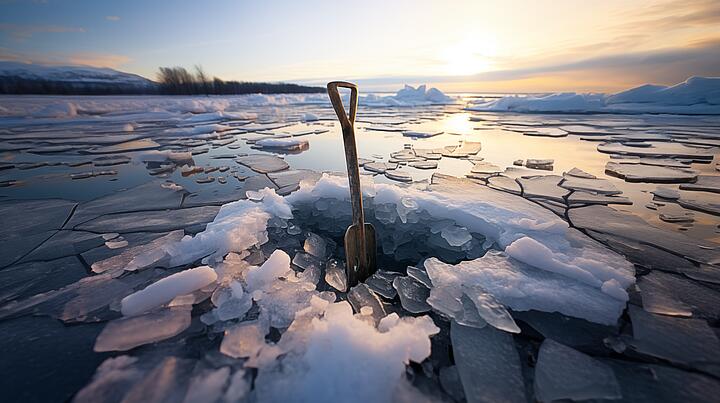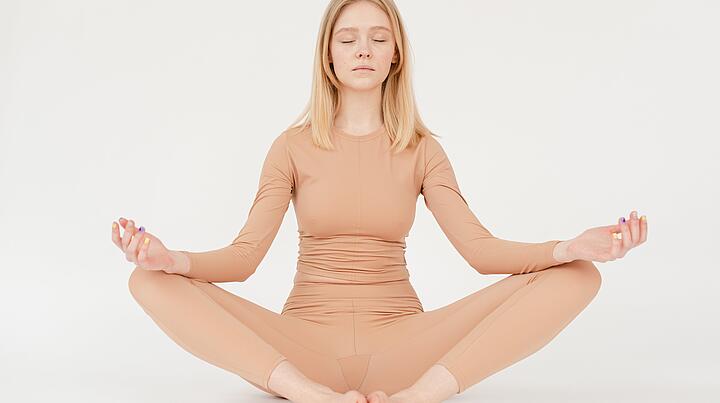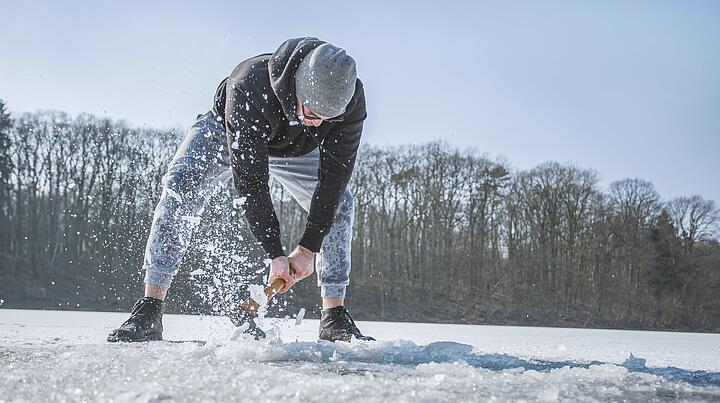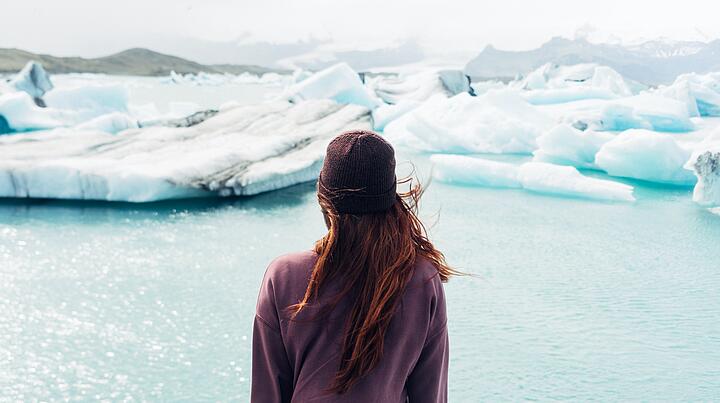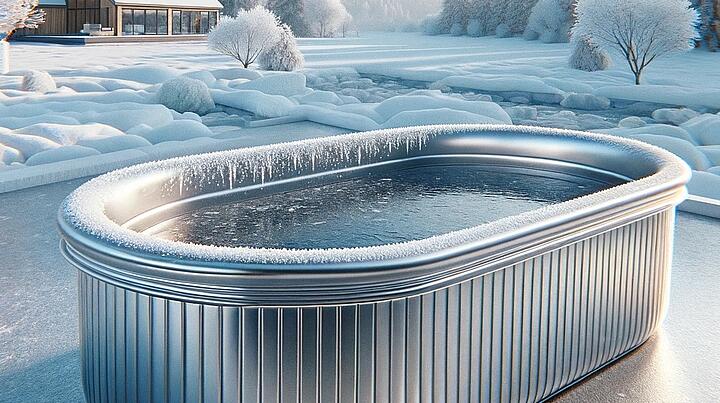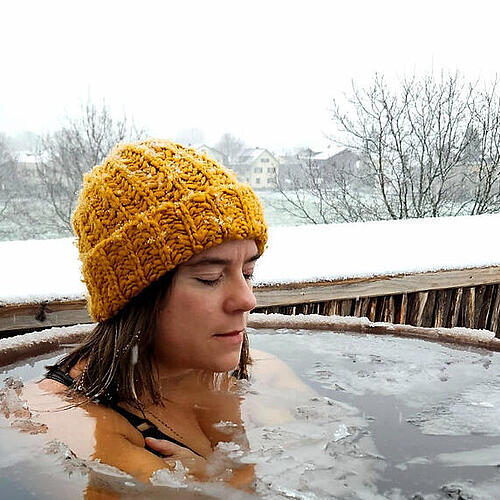What are the health benefits of ice bathing? //
Regular ice bathing can strengthen the immune system, improve blood circulation, reduce inflammation and increase general well-being. It can also release endorphins, leading to an improved mood.
Many people report an improved mood and a feeling of renewal after ice bathing. It can reduce stress and contribute to mental clarity.
Is ice bathing dangerous? //
Ice bathing can be risky for people with cardiovascular disease or other health problems. It is important to consult a doctor first and start slowly. Hypothermia and shock are possible risks, so a safety plan should always be in place.
How do I prepare for ice bathing? //
Good preparation includes gradually getting used to cold water, wearing suitable swimwear and making sure you are accompanied. It is also important to keep your body warm before and after swimming.
How long should you stay in the water when ice bathing? //
Beginners should start with a few minutes and gradually increase the duration. The ideal time in the water varies according to personal tolerance and experience, but should rarely be more than 10-15 minutes.
Where can I go ice bathing? //
Ice bathing can be practised in any natural body of water that is safe and legally accessible. It is important to observe local regulations and weather conditions and ensure that the water is free of hazards.
Do I need special equipment for ice bathing? //
Special equipment is not absolutely necessary, but water shoes can help to better tolerate the cold. A hat and gloves can also be useful.
Can everyone practise ice bathing? //
Ice bathing is not suitable for everyone, especially people with certain medical conditions. Children, the elderly and pregnant women should be particularly careful.
What does ice bathing do to the body? //
Ice bathing triggers a series of physical responses in the body, both immediate and long-term. When you immerse yourself in cold water, the body enters a cold shock response: blood vessels constrict, the heart rate increases and breathing becomes rapid. This reaction puts the body into a heightened alert state.
One of the most noticeable effects is improved circulation. The blood vessels narrow in the cold and then expand again during rewarming. This process trains vascular flexibility and supports cardiovascular health. The body also releases stress hormones like adrenaline and noradrenaline, which can improve focus and mental clarity.
Another benefit is the activation of brown fat tissue. Unlike white fat, brown fat generates heat and burns energy. Regular exposure to cold may increase the body's metabolic rate and energy efficiency.
Many people report a surge of euphoria or emotional release after cold exposure. This is largely due to the release of endorphins, which reduce pain, elevate mood and promote relaxation.
Ice bathing also stimulates the immune system. Repeated exposure to cold is believed to increase the production of immune cells. Scientific studies suggest that cold adaptation may lead to stronger immune responses over time.
However, responses vary between individuals. How your body reacts depends on your constitution, how often you practise, how long you stay in the cold and how you recover afterwards. Listening to your body and starting gradually is key.
What is ice bathing good for physically and mentally? //
Ice bathing is beneficial on multiple levels. Physically, it improves circulation, supports cardiovascular health, reduces inflammation and may help regulate metabolism. It also activates brown fat, which helps the body produce heat and burn calories, potentially supporting weight regulation.
Mentally, ice bathing can lead to a noticeable increase in focus, resilience and emotional stability. The brief stress exposure activates the sympathetic nervous system, which is followed by a parasympathetic rebound. This natural cycle of arousal and relaxation can help improve stress management and emotional balance.
People who practise ice bathing often describe it as a mental reset. Stepping into cold water requires presence, courage and self-control. Mastering this challenge reinforces a sense of agency and can boost confidence in everyday life.
In addition, many report improved sleep, better mood and more emotional clarity after regular cold exposure. Some even describe it as a form of meditation, because it pulls them fully into the present moment.
Overall, ice bathing helps regulate the nervous system, stabilise mental processes and reconnect with the body. These benefits unfold over time and are most effective when combined with mindful breathing and consistent practice.
How does ice bathing affect the immune system? //
Ice bathing places a short-term stress on the body, which can strengthen the immune system over time. When exposed to cold, the body responds by increasing the circulation of white blood cells and stimulating immune activity.
Scientific studies suggest that repeated cold exposure may enhance the function of natural killer cells, which help defend the body against viruses and other pathogens. The body also releases noradrenaline, a hormone that plays a role in both alertness and immune response. It may help reduce inflammation and promote resilience.
The concept of hormesis is relevant here. This is the idea that the body becomes stronger when exposed to small, manageable stressors. Regular cold exposure, when done safely, acts as such a stimulus and may help the immune system respond more efficiently.
Many experienced cold practitioners report that they become sick less often or recover faster from illnesses. While these reports are anecdotal, they align with current research.
Still, ice bathing is not a replacement for healthy living. Balanced nutrition, sleep and movement remain the foundation of a robust immune system. But as an additional practice, ice bathing can support your body's natural defences and improve its adaptability.
What role does breathing play in ice bathing? //
Breathing is a key element of safe and effective ice bathing. When you first enter cold water, your body often reacts with gasping or rapid breathing. This cold shock response can feel overwhelming, but conscious breath control helps you stay calm and in control.
Slow, deep breathing activates the parasympathetic nervous system and counteracts the stress response. Before entering the water, many people use breathing techniques to prepare the body and mind. This might include slow nasal breathing, box breathing or the Wim Hof method, depending on your preference.
Once in the water, staying focused on a calm, steady breath helps stabilise your heart rate and mental state. Shallow or erratic breathing can increase stress, while deep breathing helps you access inner calm and stay relaxed.
After the cold exposure, continuing to breathe consciously supports your recovery. It helps the nervous system shift from activation to rest and speeds up the rewarming process.
Overall, breathing is more than a safety tool. It is a bridge between body and mind, helping you regulate your experience, stay present and deepen your awareness during cold exposure.
How often should you practise ice bathing? //
The frequency of ice bathing depends on your personal goals, health status and experience level. Beginners often start with one session per week. This allows the body to adjust gradually and helps avoid overstimulation.
More experienced practitioners may bathe two or three times a week. Some even go daily, especially during winter. However, daily exposure should be approached with caution. Watch for signs of fatigue, poor sleep, low mood or prolonged coldness, as these could signal overtraining or nervous system imbalance.
Rest and recovery are just as important as the cold exposure itself. Your body needs time to integrate the effects, especially in the beginning.
Seasonal changes also play a role. In autumn, the water is less cold, which allows for a gentle transition. In winter, the exposure is more intense and may require more rest between sessions.
Consistency is more important than intensity. A regular rhythm, even once a week, can be more effective than sporadic extremes. Listening to your body is the most reliable guide.
What should I keep in mind after ice bathing? //
Aftercare is essential to get the most benefit from ice bathing and to ensure your body rebalances properly. The first priority is to warm up gradually. Gentle movement like walking, swinging your arms or light stretching helps restore circulation.
Avoid jumping into a hot shower immediately. Sudden rewarming can cause dizziness or strain the heart. Instead, put on dry, warm clothes as quickly as possible. Layering is key, especially socks, gloves and a hat, as the extremities lose heat fastest.
A warm drink like herbal tea supports internal rewarming and helps you feel grounded. A small snack can also stabilise blood sugar and energy levels.
Refrain from intense physical activity right after your cold exposure. The nervous system is in a delicate rebalancing phase, and pushing too hard may reduce the recovery effect. Also wait before driving if you feel light-headed or chilled.
Check in with your body for the rest of the day. If you feel tired or chilled later, allow yourself to rest. Ice bathing is not only a physical experience, but also a hormonal and emotional one.
With the right aftercare, your body will respond with resilience and a growing capacity to handle challenges.
Are there health reasons not to practise ice bathing? //
Yes, there are certain medical conditions that may make ice bathing unsafe. People with heart disease, high blood pressure, angina or arrhythmias should consult a doctor before trying cold exposure. The shock of cold water can put significant strain on the cardiovascular system.
Individuals with respiratory issues, uncontrolled asthma or circulation problems should also be cautious. Cold water immersion can trigger constriction in the airways or cause the body to lose heat too quickly.
Pregnant people, those with severe anxiety or trauma histories, or individuals with low body weight should approach ice bathing gently and only with proper support. Children and older adults may require extra safety precautions.
Anyone with an acute infection, fever or flu should avoid cold exposure until fully recovered. Ice bathing may delay healing or worsen symptoms if the body is already under stress.
If you are unsure whether ice bathing is safe for you, start slowly and seek guidance from a medical professional. A gradual approach with respect for your body's signals is always the best path.



